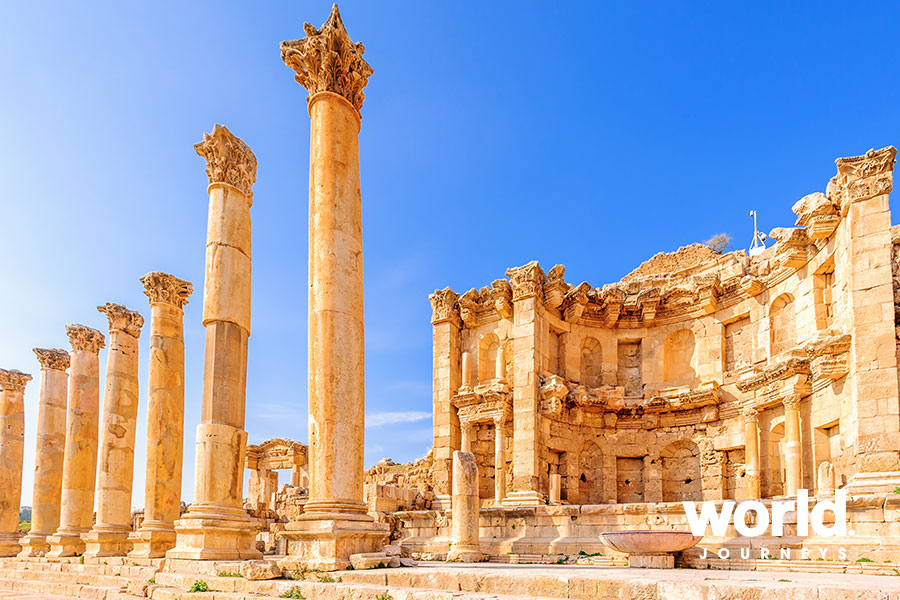Jordan Tours
Step back in time in the Kingdom of Jordan.
Beside the ancient city of Jerash, one of the best preserved Roman provincial towns in the world and boasting 6,500 years of human habitation as well as Wadi Rum and the Dead Sea, the jewel in Jordan’s crown would have to be the Rose Red city of Petra. Set deep inside a narrow desert gorge, the siq opens dramatically to reveal Petra in all her glory. Literally hundreds of buildings, temples, archways and a 3,000 seat theatre adorn this spectacular city, hidden for centuries.
Read More...Jerash
The ancient city of Jerash is one of the best preserved Roman provincial towns in the world and boasting 6,500 years of human habitation.
The Dead Sea
The lowest body of water on earth the Dead Sea is devoid of life due to an extremely high salt content, which gives its waters theraputic qualities and buoyancy. Because the salt content is four times that of most world’s oceans, you can float in the Dead Sea without even trying, and the only place in the world where you can recline on the water to read a newspaper! A truly unique experience!
Petra
The Rose Red City of Petra is set deep inside a narrow desert gorge opening dramatically to reveal the Treasury. An architectural and historical marvel with literally hundreds of buildings, temples, archways and a 3000 seat theatre. Travel on foot or on horseback through the ‘Siq’ to the Treasury, then to the Street of Facades, the Theatre, Royal Tombs and much more.
Wadi Rum
Also known as ‘The Valley of the Moon’ , Wadi Rum is a protected area covering 720sqm of dramatic desert wilderness with narrow canyons cut deep into the mountains. This is the place where Prince Faisal Bin Hussein and T.E. Lawrence based their headquarters during the Arab Revolt against the Ottomans in World War 1, later made famous in the Lawrence of Arabia movie.
Mt Nebo
Mt Nebo sits at an elevation of approximately 817 metres above sea level, and on a clear day the view from the summit provides a panorama of the Holy Land and the cities of Jericho and Jerusalem.
The best time to travel is March – November although the summer months July – August can be quite hot and dry. Many people do not realise it can snow in Jordan over the winter so it is best to avoid choosing your travel between December – February!
I tried really hard not to hum the Indiana Jones theme as I neared the end of the siq but it came out under my breath anyway…and what a sight! No photo can quite prepare you for your first glimpse of the soaring facade of Al-Kazenehis (or Treasury) as you pass through the narrow entrance. A local guide will help bring the city to life and it is very easy to spend several hours here. Other fabulous highlights include Wadi Rum where you could easily be on another planet, Jerash, a stunning Roman city and the Dead Sea, the lowest point on earth. With a more western outlook but a distinct Middle Eastern flavour, Jordan may seem less of a culture shock than other areas in the Middle East. Talking of flavour, Jordanian food is based around the staples of chickpeas, lentils, beans and flat bread with typical Middle Eastern aromas. Do try the national dish of Mansaf, a sort of stewed lamb in yoghurt.
Kate Couling, Director
Currency Jordanian Dinar
Language Arabic
Why we love it Jordan has a fair dose of history and culture – there really is nothing quite like walking through the siq to the site of Petra for the first time, or wandering in the strange and eery moonscape of Wadi Rum or standing atop Mt Nebo where Moses cast his eyes across the Promised Land but the whole country has a vibe that really appeals. This probably has a lot to do with the Jordanian people, proud and passionate and very welcoming.
Weather Jordan can be visited year round although the winter can be quite cold and snow is not unusual. Best time to travel is spring (March to May) and autumn (September – November). The Jordan Valley is extremely uncomfortable in the summer, hot and humid but other areas less so.
Social customs & quirks Predominantly muslim but with a more western outlook than much of the rest of the Middle East, it is still wise to be conservative in your dress, particularly if visiting religious sites. The Jordanians are passionate, hospitable and friendly, very proud to be Jordanian. Meeting someone for the first time requires a firm handshake, direct eye contact and a smile. Eating from shared plates using your hands is often the norm, use only your right hand and if seated on the floor, it is impolite to point the soles of your feet at anyone else.
Festivals & events There are many religious and cultural festivals and celebrations throughout the year, the biggest being Ramadan, or Holy month of fasting. Muslims should refrain from eating, drinking or smoking during daylight hours. The conclusion of Ramadan is the ‘Aid’, a huge celebration where the children receive gits of new clothes and money and much feasting is enjoyed across the country.
Health* Currently there are no compulsory health requirements for Jordan
Notes *Please be aware that Health information is subject to change at any time and you should always double check these requirements at the time of booking and before travel.






